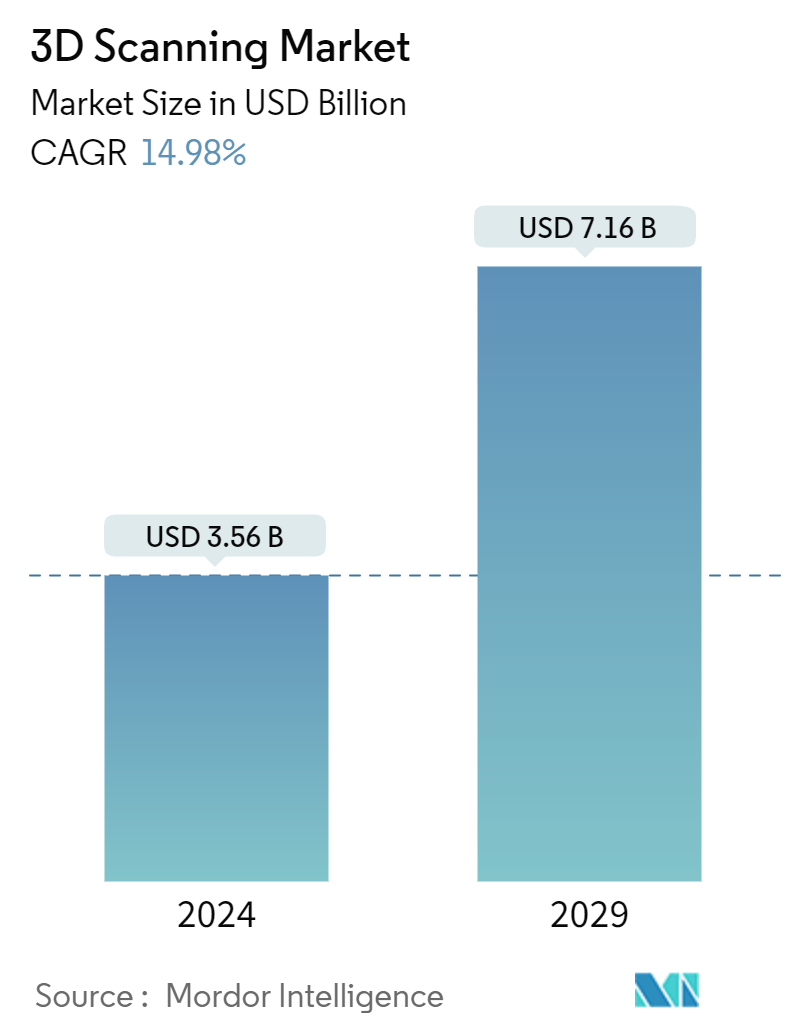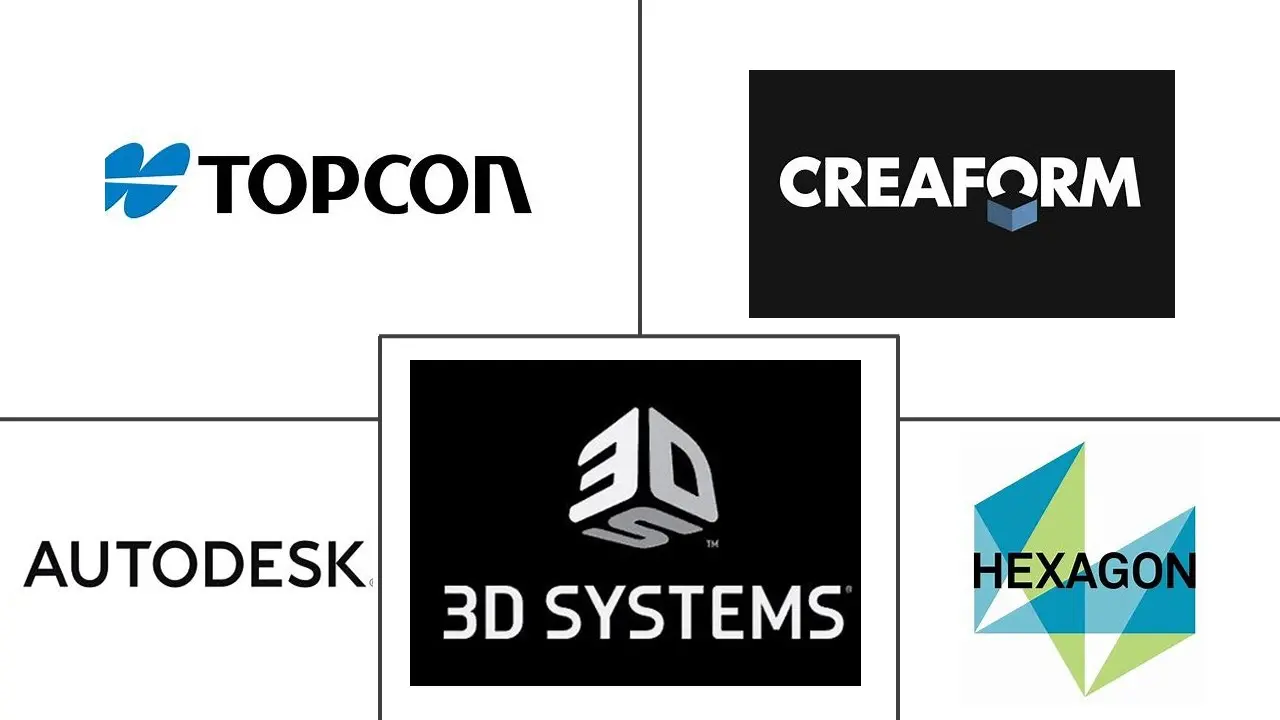Market Size of 3D Scanning Industry

| Study Period | 2019 - 2029 |
| Market Size (2024) | USD 3.56 Billion |
| Market Size (2029) | USD 7.16 Billion |
| CAGR (2024 - 2029) | 14.98 % |
| Fastest Growing Market | Asia Pacific |
| Largest Market | North America |
Major Players
*Disclaimer: Major Players sorted in no particular order |
3D Scanning Market Analysis
The 3D Scanning Market size is estimated at USD 3.56 billion in 2024, and is expected to reach USD 7.16 billion by 2029, growing at a CAGR of 14.98% during the forecast period (2024-2029).
Though 3D scanning technology has not penetrated residential and private settings, these devices are prominently used to produce video games and movies in industries such as entertainment and media. Other industrial applications where these devices are found to be of great use are architecture, construction, aerospace, healthcare, and automotive, among others, where these can be used for onsite parts production. 3D scanners have been a part of the innovations led by applications.
- 3D scanning technology witnessed considerable adoption from commercial applications. Further, the flexibility of the technology to be customized to meet professional needs in various industries has made it profoundly popular across major end-user industries.
- Furthermore, 3D scanners are used in the construction industry to create a scaled 3D many-building structure. In the architectural industry, these devices help preserve and archive historical monuments from museums. Due to this technology's customizability and scalability, manufacturers rely on measurement accuracy and speed when building and developing advanced military and defense systems, using 3D scanners in making weapons and vehicles, such as frigates.
- Moreover, the growing construction or infrastructure activities across the globe will increase the demand for 3D scanning during the projected timeline. According to IBEF, the government has dramatically pushed the infrastructure sector by allocating USD 130.57 billion to enhance the infrastructure sector in India. Additionally, India plans to spend USD 1.4 trillion on infrastructure through the 'National Infrastructure Pipeline' in the following five years.
- In the medical sector, 3D scanners are used to model body parts in three dimensions, which are used to create prosthetics. It can also facilitate wound healing and care and generate body implants. 3D scanners are widely used by healthcare and medical professionals for creating custom-fit orthotic solutions, back braces, ergonomic prosthetic devices, dental implants, measurements, etc.
- Moreover, the increasing elderly population is expected to boost the demand for advanced technologies in the medical industry. According to the Burden of Digestive Diseases in the United States, it is estimated that more than 20 million GI endoscopies are performed yearly in the United States, whereas a total of 75 million endoscopies are performed in the U.S. every year. Also, as per the American Cancer Society, It is estimated that in 2023 there will be a total of 238,340 new cases of lung and bronchus cancer in the United States.
- Additionally, the rising adoption of 3D printing technology in various industries is one of the major factors thriving the adoption of 3D printers. As the adoption of 3D printers grows, the need for 3D scanning systems will increase simultaneously, driving market growth. 3D printers are experiencing this inflection point, likely because companies across multiple industries are increasingly using 3D printing technologies for more than just rapid prototyping.
- 3D scanning as a non-contact technique helped the thoracic chest scanning for COVID-19. The outbreak of this respiratory disease led to using 3D scanning technology as a useful tool to detect and quantify the COVID-19 virus.
3D Scanning Industry Segmentation
3D scanners capture the details of a real-world object, including dimensions, texture, and color, which can then be used to reproduce 3D models. As part of the study's scope, 3D scanning equipment and software have been considered. Optical scanners, structured light scanners, and laser scanners have been considered within the hardware.
The 3D scanning market is segmented by Type (Hardware, Software), Range (Short, Medium, Long), Application (Reverse Engineering, Rapid Prototyping, Quality Control/Inspection, Industrial Metrology, Face and Body Scanning, Digital Modeling), End-user Vertical (Aerospace and Defense, Automotive, Healthcare, Manufacturing, Media and Entertainment, Architecture and Construction), and Geography (North America, Europe, Asia Pacific, Latin America, and Middle East and Africa). The report offers the market size in value terms in USD for all the above mentioned segments.
| By Type | ||||||
| ||||||
| Software |
| By Range | |
| Short Range | |
| Medium Range | |
| Long Range |
| By Application | |
| Reverse Engineering | |
| Rapid Prototyping | |
| Quality Control/Inspection | |
| Face and Body Scanning | |
| Industrial Metrology | |
| Digital Modeling |
| By End-user Vertical | |
| Aerospace and Defense | |
| Automotive | |
| Healthcare | |
| Manufacturing | |
| Media and Entertainment | |
| Architecture and Construction | |
| Other End-user Verticals |
| By Geography | |
| North America | |
| Europe | |
| Asia Pacific | |
| Latin America | |
| Middle East and Africa |
3D Scanning Market Size Summary
The 3D scanning market is poised for significant growth, driven by its expanding applications across various industries. While the technology has yet to penetrate residential and private sectors, it is extensively utilized in entertainment and media for video game and movie production. Industries such as architecture, construction, aerospace, healthcare, and automotive leverage 3D scanning for onsite parts production and other innovative applications. The technology's ability to customize and scale according to professional needs has made it increasingly popular among major end-user industries. In construction, 3D scanners are used to create scaled models, while in healthcare, they assist in modeling body parts for prosthetics and implants. The rising adoption of 3D printing technology further fuels the demand for 3D scanning systems, as these technologies become integral to advanced manufacturing processes.
The market is characterized by a high level of competitive rivalry, with both large and small companies driving innovation through new product developments. The United States stands out as a significant market, with substantial contributions from sectors like healthcare, aerospace, defense, and entertainment. Canada also plays a crucial role, with government investments supporting the creative industries and healthcare sector. The market's fragmentation is evident in the diverse range of applications, from reverse engineering and augmented reality to fashion retailing and automated optical inspection. Recent advancements include the introduction of multifunctional 3D scanners with enhanced accuracy and precision, catering to various industrial needs. As infrastructure activities grow globally, the demand for 3D scanning technology is expected to rise, further propelling market expansion during the forecast period.
3D Scanning Market Size - Table of Contents
-
1. MARKET INSIGHTS
-
1.1 Market Overview
-
1.2 Industry Value Chain Analysis
-
1.3 Industry Attractiveness - Porter's Five Forces Analysis
-
1.3.1 Bargaining Power of Suppliers
-
1.3.2 Bargaining Power of Buyers
-
1.3.3 Threat of New Entrants
-
1.3.4 Threat of Substitute Products
-
1.3.5 Intensity of Competitive Rivalry
-
-
1.4 Assessment of the Impact of COVID-19 on the Market
-
-
2. MARKET SEGMENTATION
-
2.1 By Type
-
2.1.1 Hardware
-
2.1.1.1 Optical Scanners
-
2.1.1.2 Structured Light Scanners
-
2.1.1.3 Laser Scanners
-
2.1.1.4 Other Hardware
-
-
2.1.2 Software
-
-
2.2 By Range
-
2.2.1 Short Range
-
2.2.2 Medium Range
-
2.2.3 Long Range
-
-
2.3 By Application
-
2.3.1 Reverse Engineering
-
2.3.2 Rapid Prototyping
-
2.3.3 Quality Control/Inspection
-
2.3.4 Face and Body Scanning
-
2.3.5 Industrial Metrology
-
2.3.6 Digital Modeling
-
-
2.4 By End-user Vertical
-
2.4.1 Aerospace and Defense
-
2.4.2 Automotive
-
2.4.3 Healthcare
-
2.4.4 Manufacturing
-
2.4.5 Media and Entertainment
-
2.4.6 Architecture and Construction
-
2.4.7 Other End-user Verticals
-
-
2.5 By Geography
-
2.5.1 North America
-
2.5.2 Europe
-
2.5.3 Asia Pacific
-
2.5.4 Latin America
-
2.5.5 Middle East and Africa
-
-
3D Scanning Market Size FAQs
How big is the 3D Scanning Market?
The 3D Scanning Market size is expected to reach USD 3.56 billion in 2024 and grow at a CAGR of 14.98% to reach USD 7.16 billion by 2029.
What is the current 3D Scanning Market size?
In 2024, the 3D Scanning Market size is expected to reach USD 3.56 billion.

